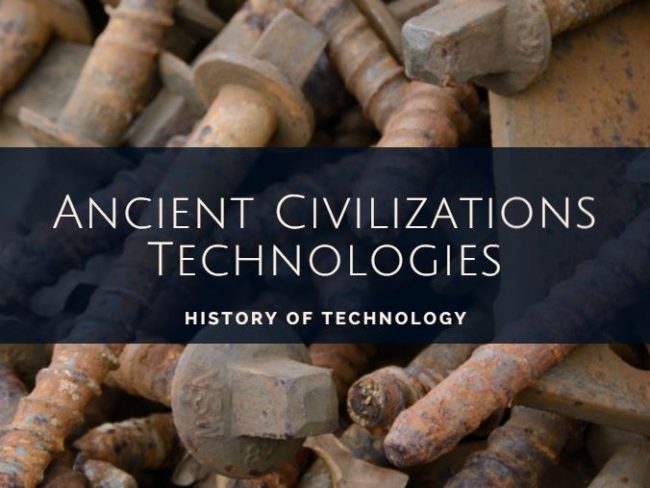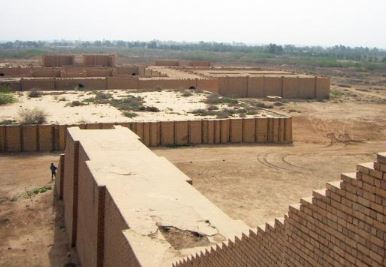Technology has been a key cumulative process in the human experience. It can be best understood in a historical context that traces the evolution of early human beings from a period featuring the use of very simple tools to complex large-scale networks that have an impact on most contemporary human life. In order to maintain simplicity in the following summary, the developments of the industrialized world are dealt with in more detail, but some developments from other cultures are also included.

Technology in Ancient Civilizations
Contents
Primitive Technology
The earliest known human artifacts are handmade stone axes found in Africa, East Asia, and Europe. They date back to approximately 250,000 BC and mark the beginning of the Stone Age. The first tool makers were nomadic groups of hunters who used the sharp sides of stones to cut their food and make clothes and tents. From around 100,000 BC the caves of modern man’s hominid ancestors contained oval axes, scrapers, knives, and other stone implements that indicated that the original hand ax had become a tool to in turn make other tools. Many members of the animal kingdom use tools, but this ability to create tools that, in turn, are used to make other tools sets humans apart from other living beings.
The next big step in technology was controlling fire. Striking stones against pyrites to produce sparks made it possible to start fires and freed them from the need to maintain fires from natural sources. In addition to the obvious benefits of heat and light, fire was also used to cook clay pots, sturdy containers that could be used to cook grains as well as for brewing and fermentation.
Early technology wasn’t just limited to practical tools. Different color minerals were pulverized to obtain pigments, which were applied on the human body, clay utensils, baskets, clothes and other objects. In their search for pigments, ancient people discovered the green mineral malachite and the blue mineral azurite. When they struck these ores, which were rich in copper, they didn’t turn into a powder, but they bent; they could be polished, but not broken. Due to these qualities, small pieces of copper were used in jewelry very shortly after.
These people also learned that if this material was repeatedly forged and put over a fire, it wouldn’t split or crack. This process of removing stresses from the metal, called annealing, was developed by Stone Age civilizations and was used especially from around the year 3000 BC when they also discovered that tin and copper alloy produced bronze. Bronze isn’t just more malleable than copper, but it also has a finer edge, a necessary quality in objects like sickles and swords.
Although there were copper deposits in Syria and Turkey, at the headwaters of the Tigris and Euphrates rivers, the largest copper deposits in the ancient world were found on the island of Crete. With the development of boats that could reach this extremely valuable resource, Knossos (in Crete) became a rich mining center during the Bronze Age.
Development of Agriculture
When the Bronze Age arrived, different societies on each continent had already made several technological advances. Barbed harpoons, bow and arrows, animal oil lamps and bone needles were developed, used to make containers and clothing. They also underwent a major cultural revolution: the shift from nomadic hunter-gatherer societies to sedentary agricultural ones.

The first agricultural communities emerged at the end of the most recent ice age (around 10,000 BC). Their remnants can be found in areas far away from each other, from Southeast Asia to Mexico. The most famous were in Ancient Mesopotamia (present-day Iraq) in the valleys of the fertile, temperate banks of the Tigris and Euphrates. The soil in these fertile hillsides was ideal for planting and had a large number of trees for firewood.
By 5000 BC, farming communities were established in many parts of the world, including the areas we know today as Syria, Turkey, Lebanon, Israel, Jordan, Greece, and the islands of Crete and Cyprus. Agricultural societies built stone buildings, used sickles to harvest cereals, developed a primitive plow, and improved their metallurgy techniques. The trading of stones also began. By 4000 BC, agriculture spread westward from these centers to the Danube River in central Europe, south to the Mediterranean coast of Africa (including the Nile River), and eastward to the Indus Valley.
The development of the Nile Basin led to other technological advances. The river floods at the beginning of spring in the Nile Valley. An irrigation system and canals had to be developed to irrigate crops during harvest seasons when rainfall is insufficient. Land ownership had to be determined each year through a measurement system, as property markers were frequently lost to floods. The Tigris and Euphrates valleys presented other technological problems. Flooding occurred after the harvest season, so they needed to learn how to build levees and flood barriers.
Other Early Discoveries
To provide the growing copper industry with efficient mineral transportation, two-wheeled carts were built (the oldest wheel approximately dates back to the year 3500 BC in Mesopotamia). However, the most commonly used means of transport were reed boats and wooden rafts, which first emerged in Mesopotamia and Egypt. An important finding in ceramics, metals and raw materials markets was the creation of a mark or seal, which was used to identify creators or owners.
Technology also began to have another impact, a major alteration of the environment through the introduction of new practices. For example, demand for firewood led to deforestation, and excessive sheep and cattle grazing caused fewer trees to grow on the region’s poor lands. Thus, animal husbandry, monoculture farming, deforestation and periodic flooding led to the gradual emergence of deserts.
The Development of Cities

After 4000 BC, one of humanity’s most complex creations appeared: the city. With this, technology cannot just be described in terms of simple tools, agricultural advances and technical processes like metallurgy, as cities are technological systems in themselves. This is evident in the first written symbols used to represent cities: a circle with networks of lines that indicate the first transport and communication systems.
The appearance of the city made food surpluses and an abundance of material wealth possible that led to the construction of temples, tombs, and walls. The accumulation of precious metals, the construction of defensive walls, and control over armies and priests guaranteed the rise of the king, who could be described as the first urban technician.
The ziggurats of Mesopotamia and the pyramids of Egypt or Mexico symbolize the organizational power and technological magnitude of the first urban settlements.
The construction of these huge buildings and monuments, the growth of the market of metal products and the development of water resources also led to the standardization of measurement systems. In Mesopotamia, the cubit was used for length. Time was measured in Egypt using a calendar that divided the annual seasonal cycle into days and months.
The growth of cities also increased the need for writing. The Egyptians improved upon the clay tablet, which was difficult to use, by making a material similar to paper which they wrote on using hieroglyphs. This material was made using the papyrus plant. In addition, cities brought about a new division of labor: the caste system. This structure provided security, social status, and leisure to the intellectual class of scribes, doctors, teachers, engineers, mages, and sorcerors. However, the army had the greatest resources.
The Rise of the Army
The first cities were also built inside walls for defense and were organized for battle and conquest. The urban centers of Ur, Nippur, Uruk, Thebes, Heliopolis, Assur, Nineveh and Babylon were arsenals of destructive weaponry. The aim of a military force was to devastate its enemy’s city. Ur, in Sumeria, wasn’t just one of the first great cities to rise (in about 4000 BC), but it was also one of the first to be destroyed (in approximately 2000 BC). Similarly, in the Indus Valley, the great city of Mohenjo-Daro was founded in around 2500 BC and destroyed in around 1700 BC by chariot armies from the north. The same thing happened in Peru and Ecuador around 1000 BC and later in Mexico and Central America.
Military technology in the ancient world developed in three disjointed phases. In the first phase, infantry emerged with skin or copper helmets, bows, spears, shields, and swords. This phase was followed by the development of chariots, which were originally heavy-duty vehicles used by commanders. The later inclusion of spokes on the wheels to make them lighter, and a bit and a bridle for the horse, made the chariot a light war machine that could outrun the enemy infantry. The third phase focused on increasing the mobility and speed of cavalry. The Assyrians, with their knowledge of iron weaponry and their magnificent horsemen, dominated most of the civilized world between 1200 and 612 BC.

With the introduction of the stirrup in Asia, approximately in the 2nd century BC, riders were able to improve stability in sword fighting, which made war chariots obsolete. Rapid attack cavalry units, which were first seen in Egypt and Persia, became the leading military forces. The need for better transportation and communication systems arose along with them. The Persians were the first to develop a network of roads and stations for travel around their vast empire, which stretched from the Punjab to the Mediterranean Sea.
Greek and Roman Technology
Cyrus the Great’s Persian Empire was defeated and succeeded by Alexander the Great’s empire. The Greeks were the first to become a power through their knowledge of shipbuilding and commerce, and due to their colonization along the Mediterranean coasts. The defeat of the Persians was partly due to Greek naval power.
Persians and Greeks also introduced a new caste in the division of labor: slavery. During the Greek golden age, their civilization depended on slaves for everything concerning manual labor. The majority of scholars agree that in societies where slavery was practiced productivity problems were solved by increasing the number of workers rather than by using new methods of production or new sources of energy. Due to this, theoretical knowledge and teaching in Greece (and later in Rome) were far removed from physical labor and manufacturing.
This isn’t to say that the Greeks didn’t develop new technological ideas. Archimedes, Hero of Alexandria, Ctesias and Ptolemy wrote about the inception of siphons, pulleys, levers, cranks, fire pumps, gearwheels, valves, and turbines. Some important practical contributions made by the Greeks were Ctesias’s water clock, Hero of Alexandria’s dioptra (a surveying instrument) and Archimedes’ hydraulic screw. Similarly, Thales of Miletus improved navigation by introducing the use of triangulation and Anaximander shaped the first map of the world. However, the technological advances made by the Greeks wasn’t on a par with their contributions to theoretical knowledge.
The Roman Empire that conquered and succeeded the Greeks was similar in this respect. The Romans, however, were great technicians in terms of organization and construction. They established an urban civilization that enjoyed the first long period of peace in human history. The first major change that occurred in this period was in engineering with the construction of huge public works systems. With the use of waterproof cement and the principle of the arch, Roman engineers built 70,800 km of roads throughout their vast empire. They also built many circuses, public baths and hundreds of aqueducts, sewers, and bridges; they were also responsible for the introduction of the water mill and the subsequent design of hydraulic wheels with upper and lower thrust, which were used to grind grain, saw wood and cut marble. In terms of the military, the Romans advanced technology with the improvement of weaponry, like the javelin and the catapult.
Middle Ages

The historical period between the fall of Rome and the Renaissance (about 400 to 1500) is known as the Middle Ages. Contrary to popular belief, great technological advances occurred in this period. In addition, the Byzantine and Islamic cultures that flourished at this time made important strides in areas of natural philosophy, art, literature, and religion. In particular, Islamic culture provided many scientific contributions, which were of great importance in the European Renaissance. Medieval society easily adapted, and was willing to acquire new ideas and methods of production from any source, be it from the cultures of Islam and Byzantium, China, or from the far-flung Vikings.
War and Agriculture
In military technology, cavalry was improved as a military force, with the invention of the spear and the saddle in around the 4th century; heavier armor, the rearing of larger horses and the construction of castles also developed. The introduction of the spring, and later gunpowder from China, led to the manufacturing of pistols, guns, and mortars (through the development of the blast chamber), thus reducing the effectiveness of heavy shields and stone fortifications.
One of the most important machines in medieval times was the mill, which not only increased the quantity of milled grain and lumber but also improved the training of millers who were experts in composite cranks, levers and other machine moving techniques, combining parts with other mechanisms. The spinning wheel, which was developed in India in the 13th or 14th century, improved yarn production and garment sewing and became a common household machine. The home itself was also transformed with the inclusion of a chimney, which saved on wood, which was increasingly scarce due to agricultural expansion. By 1000, agricultural surpluses, due to several plow improvements, led to an increase in trade and growth in cities. Architectural innovations from many kingdoms developed within them, culminating in great Gothic high-walled cathedrals, made possible thanks to flying buttresses.
Transport
Innovations in transportation during the middle ages spread the diffusion of technology over large areas. Items like the horseshoe, axle rods (to effectively harness horses to carriages) and the horse carriage accelerated the transportation of people and goods. There were also major changes in marine technology. The development of the keel, the triangular lateen sail for greater maneuverability, and the magnetic compass (in the 13th century) made sailboats the most complex machines at the time. Prince Henry of Portugal created a school to teach sailors how to use these machines correctly. Prince Henry’s students may well have done more than Copernicus’s astronomical theories had to change humanity’s perception of the world.
Other Important Inventions
Two other medieval inventions, the clock and the printing press, had a great influence on all aspects of human life. The invention of a pendulum clock in 1286 made it possible for people to no longer live in a world that followed the daily course of the Sun, and the years with the changing of the seasons. The clock was also immensely helpful in navigation, and the precise measurement of time was essential for the development of modern science.
The invention of the printing press, in turn, provoked a social revolution that still continues. The Chinese had developed both paper and a printing press before the 2nd century AD, but these innovations didn’t really reach the Western world until much later. The pioneer of the printing press, the German Johann Gutenberg, managed to mold movable types in 1450. Once developed, the printing press spread quickly and began to replace manuscripts. As a result, the Church and State were no longer the masters of intellectual life, and reading and writing became necessities in urban life.
